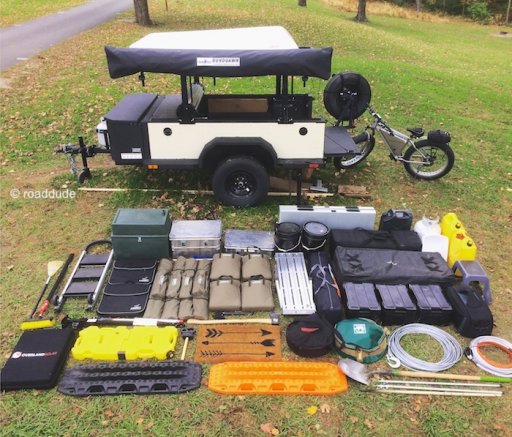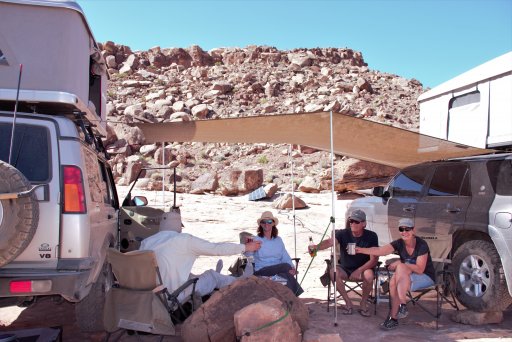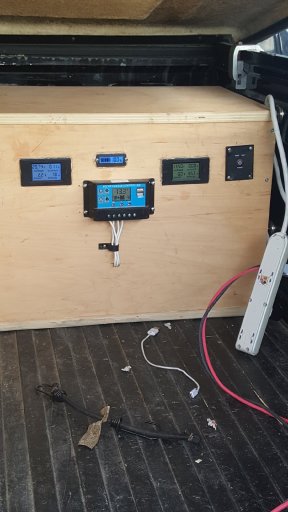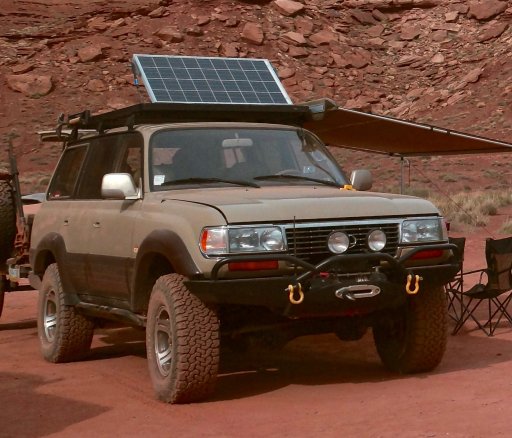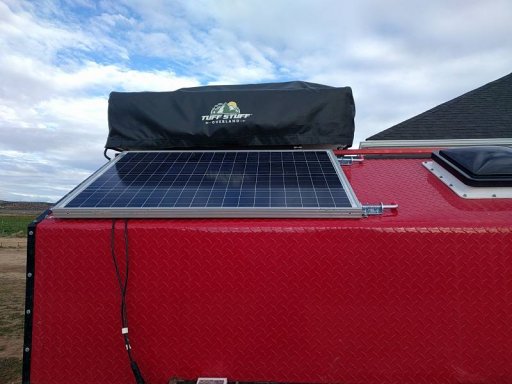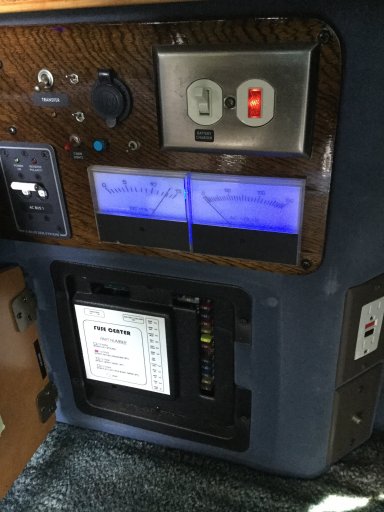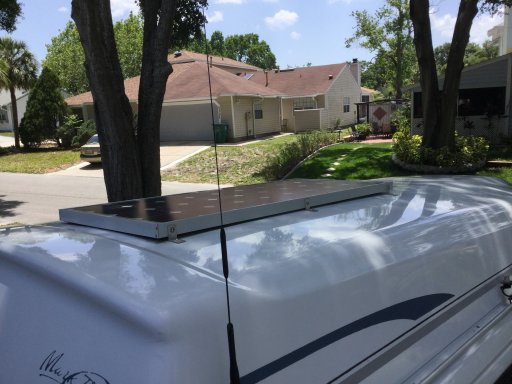
Advocate III
The quick answer:I actually have about 24" of rack space in front of my RTT where a permanently mounted panel would be perfect. I may end up getting one of these Overlandsolar panels: https://overlandsolar.com/collections/off-grid-cabin-solar/products/100-watt-sunpower-panel-osm100
The ability to charge my batteries while traveling would be a huge benefit. Whenever possible, I will try to orient my trailer facing South. That should give me the best sun from Spring to Fall. One thing I liked about the briefcase panels was the ability to angle them towards the sun. Is this really necessary, or is a flat mount facing South efficient enough? So far, the power needs of my basecamp are fairly minimal; just a 50l ARB fridge, a 12v box fan, and LED lighting.
By the way, what type of connectors do the Overlandsolar panels use? I need SAE connectors for the XV-2.
@KSTrekker, the deep cycle batteries in your trailer should be charging automatically while you drive, via your tow vehicle's alternator and trailer hookup. Doesn't take much to keep the two Odysseys in your trailer charged up while driving, and makes having a fixed panel out for the sun while driving rather unimportant.
A folding panel usually comes with the SAE connector that will work with your XV-2, as it's pretty standard. My 120w folding panel from OS did. Also comes with a 15' heavy gauge lead with the SAE on the end. A flat panel meant to be permanent may not have the SAE connector you need, nor will it have a nice case or cord. Part of what makes a folding panel more expensive. You can easily get the SAE plug and a cord, though, if you choose to go with a flat panel over folding.
The long answer:
Tip: If the batts in the trailer are not yet fully charged from driving, I usually unhook the trailer connection if gone from my rig for more than an hour or when parked overnight, because I don't want my tow vehicle batteries being drained. If you have an isolator set up to separate battery banks when the engine is off, that's a moot point.
If you do go with a fixed flat panel, you'll find that having to regularly orient the front of your trailer to the south when parked/camped will prove to be a pain in the ass. I wrote a long piece about fixed or movable panels here: https://www.overlandbound.com/forums/threads/on-trail-camp-solar-power.10845/#post-186118
Here are a bunch of other random points to consider when using solar panels for camping, some covered in the linked piece above.
- You will also be using the batteries for your trailer's water pump if it has one, to charge multiple mobile USB devices while in camp, and possibly battery chargers for camera, flashlights, and cordless tools, if you have an inverter to convert the deep cycles 12v to 110. An inverter is handy to have. A 'Pure Sine Wave' inverter as opposed to 'True Sine' or modified sine wave will provide cleaner power for computers, etc.
- The ARB 50 fridge, once at desired temp, only draws about 1.2 amp, I believe. They are amazingly efficient. So much so that I keep mine in my van and run it off the vehicle batteries, not the trailer's. I get it to temp, then often unplug it for hours and it may raise only a couple degrees. I usually set mine about freezing or just below, which allows the deepest stuff to get really cold and everything else around normal fridge temps. In cooler weather like late Autumn, when outdoor temps may dip into the 50's and 40's or below, I may have it plugged in only when I drive somewhere and leave it unplugged from power the rest of the day and overnight. I prefer keeping the fridge in my van so I have food and drink with me if away from camp for the day. It also fits into my workflow quite well right inside the back door of my van. If I really need to, I can plug it into the 12v of the trailer via a long 12v cord I have. Noco makes a nice one, though you can often find good ones at bigger truck stops as well. You want heavy gauge as possible.
- If you choose to go with a single 100w panel, whether fixed or movable, you'll have 20watts less than OS's 120w folding panel. Having 20% more in a panel means more efficient and quicker charging of your deep cycle batteries. The Renogy folding panel is 100w, less expensive per watt, but not as efficient in the latest 2018 conversion figures I've seen, which makes a difference both when charging and over time owned as far as bang for your buck. Scroll down to the two 'Exhibit' graphics on this page, if interested: https://news.energysage.com/what-are-the-most-efficient-solar-panels-on-the-market/
That said, though, I think either a Renogy or Overland Solar folding panel would suffice for most people's needs when camping. Perhaps even some of the less efficient panels would do fine as well, though may not be as robust in build or last as long. I usually stay out a long time and often camp in one place a long time; my last base camp dependent on solar only was five weeks straight in the same place, so enjoy tweaking as much as I can from my system and experimenting with how to make it as efficient as possible. I mean I really enjoy it, and have taught myself a lot about off-grid living and self-sufficiency. Not everyone needs to do that or has the time to.
- Where you camp and if you unhook the trailer or not further complicates having a fixed, flat, panel.
You won't always have room to jockey vehicle and trailer around so the front of the trailer faces south for the sun. If staying only one night, you may not want to unhitch your trailer just to aim it for sun on a fixed panel. You won't always be able to move the trailer by hand, either, if unhitched, unless on flat, smooth, ground. It's a breeze to move that trailer by hand when on pavement or smooth hard ground, but don't expect to be able to in every situation.
Also important, as I wrote in the other piece, is that you will often want to keep your vehicle and trailer in available shade and not in open sun. Whether you have a fixed panel on a trailer or your vehicle, parking in the sun just so the panel is in the sun can make for an uncomfortable day in camp. It may also make it so your trailer or vehicle is not aimed efficiently for your awning to provide shade.
- Flat, permanently affixed panels are nowhere near as effective at gathering energy as a portable, tilt-able, panel aimed more directly at the sun. The sun is only straight overhead for a short period each day, and then, depending on where you are in the hemisphere, only part of the year. The sun's daily arc through the sky lowers quite a bit towards the horizon a good half the year.
Being able to optimize the angle of your panel both vertically and horizontally makes a huge difference. You can watch the gain and loss quite easily on a solar charge controller with a read out. Moving my panel from flat to optimum angle would easily double and triple the gain up to 6 and 7 amps/hr instead of hovering around 1-2 amps/hr.
- Most folding panels have a built-in sliding leg arrangement on their back that allow them to go from flat to around 45 degrees. I found the legs on my folding panel limiting in going only to 45 and being unstable otherwise. In the first and last hours of sunlight I wanted my panels at a steeper angle, so I usually leaned my folding panel against a bench I keep in camp. That way I could have it almost vertical when needed. There's an image of it aimed and ready for the morning sun in the post linked above. In any event, I'd stay away from adjustable legs that involve removing a bolt and putting it in different holes, as opposed to more simply loosening a wingnut and sliding the leg. Less to lose and have to find in the dirt.
- A panel flat on your rack in front of something taller will also limit its exposure to the sun.
My goal in setting up a campsite is to make the process efficient, quick, and easy. Enjoyable. It's no fun if it is a pain to set up and tear down or takes too long. I like to pull into a campsite, pop up the RTT and raise the rack, swing the awning out, and grab a cold drink while I start setting up my kitchen and work area, all in half an hour or less. Adding having to figure and aim the whole trailer for a solar panel, instead of just moving the solar panel where needed later, would complicate my set up more than I'd like, as well as not being anywhere near as efficient in harvesting power.
Last edited:


